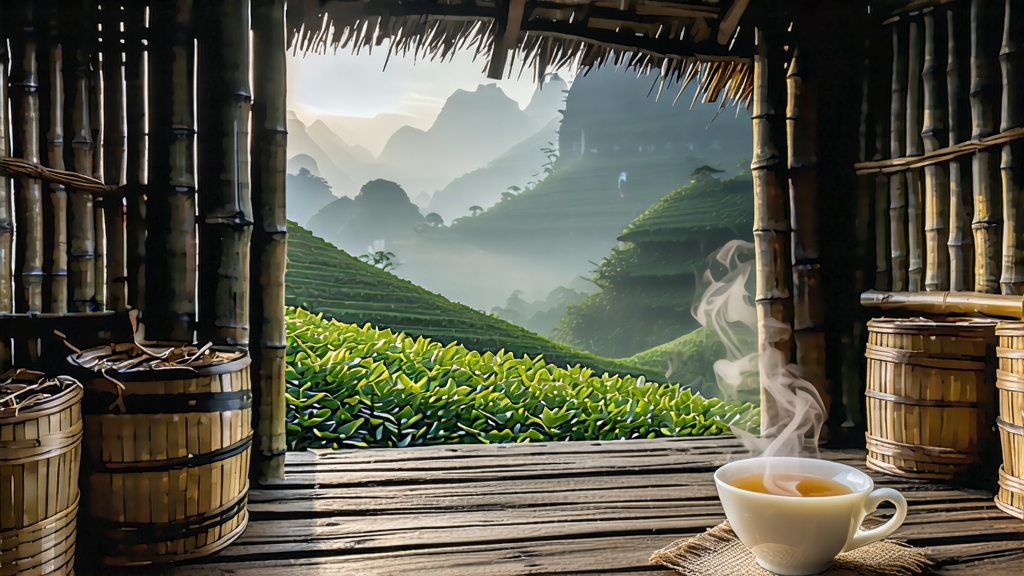
Tucked away in the humid, karst-pocked mountains of southern China’s Guangxi Zhuang Autonomous Region, Liu Bao (六堡茶, literally “Six Forts”) is the quietest celebrity of the dark-tea family. While Pu-erh grabs headlines and Fu brick dazzles with its golden “flowers,” Liu Bao has spent four centuries fermenting in obscurity, carried out on the backs of porters along the 2,000-kilometre Tea-Horse Road that once linked Guangxi to Southeast Asia. Today the tea is surging onto international menus, prized for its deep, betel-nut sweetness and its uncanny ability to taste older than it actually is. This article walks you through Liu Bao’s origin myths, micro-terroirs, craft secrets, and the gentle ritual that coaxes its best voice into the cup.
-
From Frontier Tribute to Maritime Currency
The first written record appears in the 1661 edition of the Cangwu County Annals: “The people of Liu Bao valley offer their dark tea as tribute; it calms the miasma and cuts the grease of mountain goats.” Traders soon discovered that the same microbial fermentation that stabilized the leaf for the march to Beijing also protected it from mold during the month-long junks voyages to Malacca, Jakarta, and later San Francisco. By the late 19th century Liu Bao was being pressed into 50 kg bamboo baskets, loaded onto coolie shoulders, and swapped for opium, spices, and eventually Ford parts. The tea became an unofficial currency along the Pearl River delta, and old warehouse receipts—ink still fragrant—turn up in Hong Kong antique stalls today. -
One Name, Many Faces
Liu Bao is not a single recipe but a spectrum of styles governed by three variables: leaf grade, piling intensity, and aging environment.- San Cha (散茶, loose tea): the everyday form, brewed by dockworkers since the Qing dynasty.
- Ji Jian (笠箴, bamboo-hat): 250 g nests hand-tied inside palm-leaf sleeves; the bamboo imparts a green, coconutty top note.
- Lang Cang (篮仓, basket-aged): 30–50 kg bamboo baskets stacked in humid caves near Wuzhou city; the tea absorbs minerals from the karst walls, developing a smoky, camphor finish.
- Jin Hua Liu Bao: a modern hybrid inoculated with the same Eurotium cristatum spores used in Fu brick, yielding golden flecks and a cocoa-nib sweetness.
- Lao Cha Tou (老茶头, “old tea nuggets”): accidental pebble-sized clumps that form during wet piling; they dissolve slowly, giving five-minute infusions of espresso-dark liquor.
-
Craft: The 48-Hour Sweat
The journey begins in late April when the mist lifts just enough to reveal the first two leaves and a bud of the local Da Ye cultivar. After a brief outdoor withering, the leaves are wok-fried at 280 °C for eight minutes—long enough to kill green enzymes but short enough to preserve surface microbes. The real star is the “wet piling” step: leaves are sprayed with Wuzhou’s mineral-rich river water, heaped 70 cm high under tarpaulins, and left to ferment for 48 hours while internal temperatures climb to 55 °C. Masters gauge readiness by smell: the pile must exhale the scent of steamed sticky rice mixed with dried longan. When the signal arrives, workers turn the heap, scatter it onto bamboo trays, and sun-dry for one day before moving the tea into aging bamboo baskets. There the tea will hibernate, breathing the valley’s 85 % humidity, for anywhere from three years to three decades. -
Terroir in a Basket
Unlike Pu-erh, which is often stored in temperature-controlled warehouses, traditional Liu Bao is left to the mercy of subtropical monsoons. The porous bamboo allows air exchange, while the narrow neck of the basket creates a micro-climate where yeasts dominate in summer and molds take over in winter. The result is a diurnal rhythm of fermentation that prints the valley’s geology onto the leaf: iron oxide gives a blood-orange rim to the liquor, manganese softens astringency, and fluoride (in safe, tea-bound form) delivers the cooling sensation that Cantonese drinkers call “mountain air.” -
Brewing: The Gentle Wake-Up
Liu